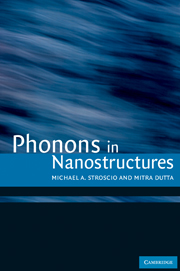Book contents
- Frontmatter
- Contents
- Preface
- Chapter 1 Phonons in nanostructures
- Chapter 2 Phonons in bulk cubic crystals
- Chapter 3 Phonons in bulk würtzite crystal
- Chapter 4 Raman properties of bulk phonons
- Chapter 5 Occupation number representation
- Chapter 6 Anharmonic coupling of phonons
- Chapter 7 Continuum models for phonons
- Chapter 8 Carrier–LO-phonon scattering
- Chapter 9 Carrier–acoustic-phonon scattering
- Chapter 10 Recent developments
- Chapter 11 Concluding considerations
- Appendices
- References
- Index
Preface
Published online by Cambridge University Press: 09 October 2009
- Frontmatter
- Contents
- Preface
- Chapter 1 Phonons in nanostructures
- Chapter 2 Phonons in bulk cubic crystals
- Chapter 3 Phonons in bulk würtzite crystal
- Chapter 4 Raman properties of bulk phonons
- Chapter 5 Occupation number representation
- Chapter 6 Anharmonic coupling of phonons
- Chapter 7 Continuum models for phonons
- Chapter 8 Carrier–LO-phonon scattering
- Chapter 9 Carrier–acoustic-phonon scattering
- Chapter 10 Recent developments
- Chapter 11 Concluding considerations
- Appendices
- References
- Index
Summary
This book describes a major aspect of the effort to understand nanostructures, namely the study of phonons and phonon-mediated effects in structures with nanoscale dimensional confinement in one or more spatial dimensions. The necessity for and the timing of this book stem from the enormous advances made in the field of nanoscience during the last few decades.
Indeed, nanoscience continues to advance at a dramatic pace and is making revolutionary contributions in diverse fields, including electronics, optoelectronics, quantum electronics, materials science, chemistry, and biology. The technologies needed to fabricate nanoscale structures and devices are advancing rapidly. These technologies have made possible the design and study of a vast array of novel devices, structures and systems confined dimensionally on the scale of 10 nanometers or less in one or more dimensions. Moreover, nanotechnology is continuing to mature rapidly and will, no doubt, lead to further revolutionary breakthroughs like those exemplified by quantum-dot semiconductor lasers operating at room temperature, intersubband multiple quantum-well semiconductor lasers, quantumwire semiconductor lasers, double-barrier quantum-well diodes operating in the terahertz frequency range, single-electron transistors, single-electron metal-oxide-semiconductor memories operating at room temperature, transistors based on carbon nanotubes, and semiconductor nanocrystals used for fluorescent biological labels, just to name a few!
The seminal works of Esaki and Tsu (1970) and others on the semiconductor superlattice stimulated a vast international research effort to understand the fabrication and electronic properties of superlattices, quantum wells, quantum wires, and quantum dots.
- Type
- Chapter
- Information
- Phonons in Nanostructures , pp. xi - xivPublisher: Cambridge University PressPrint publication year: 2001



